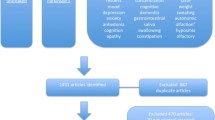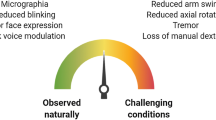Abstract
Parkinson’s disease (PD) is a progressive disease that usually affects the motor system but is also associated with a non-motor symptom (NMS) complex that ranges from dribbling saliva, constipation, depression, sleep disorders, apathy, hallucinations, and dementia. These features contribute significantly to morbidity and institutionalization, more than quadrupling the cost of care. Furthermore, recent evidence suggests that NMS such as constipation, olfaction, rapid eye movement behavior disorder, fatigue, and depression may be markers of a preclinical stage of PD. PD-NMS are not well recognized in clinical practice and part of the reason is the lack of any instrument that aims to assess the complex range of NMS of PD in a unified and integrated manner. Recently, an international, multidisciplinary PD-NMS group has developed an integrated questionnaire and scale to assess NMS of PD in a comprehensive manner. This will help improve care and treatment of PD in the future.
Similar content being viewed by others
References and Recommended Reading
Parkinson J: An essay on the shaking palsy [reprint of monograph published by Sherwood, Neely, and Jones, London, 1817]. J Neuropsychiatry Clin Neurosci 2002, 14:223–236.
Karlsen KH, Larsen JP, Tandberg E, et al.: Influence of clinical and demographic variables on quality of life in patients with Parkinson’s disease. J Neurol Neurosurg Psychiatry 1999, 66:431–435.
Aarsland D, Larsen JP, Tandberg E, Laake K: Predictors of nursing home placement in Parkinson’s disease: a populationbased, prospective study. J Am Geriatr Soc 2000, 48:938–942.
Findley L, Aujla MA, Bain PG, et al.: Direct economic impact of Parkinson’s disease: a research survey in the United Kingdom. Mov Disord 2003, 18:1139–1455. An important cost analysis of the impact of PD on societal and hospitalbased spending in the United Kingdom. Study highlights the cost implication of hospitalization and institutionalization, much of which arises from the emergence of NMS in PD.
Whetten-Goldstein K, Sloan F, Kulas E, et al.: The burden of Parkinson’s disease on society, family, and the individual. J Am Geriatr Soc 1997, 45:844–849.
Okun MS, McDonald WM, DeLong MR: Refractory nonmotor symptoms in male patients with Parkinson disease due to testosterone deficiency: a common unrecognised comorbidity. Arch Neurol 2002, 59:807–811.
Scherder E, Oosterman J, Swaab D, et al.: Recent developments in pain in dementia. BMJ 2005, 330:461–464.
Gulati A, Forbes A, Stegie F, et al.: A clinical observational study of the pattern and occurrence of non-motor symptoms in Parkinson’s disease ranging from early to advanced disease. Mov Disord 2004, 19(Suppl 9):S406.
Hely MA, Morris JG, Reid WG, Trafficante R: Sydney multicenter study of Parkinson’s disease: non-L-dopa-responsive problems dominate at 15 years. Mov Disord 2005, 20:190–199. A key study that examines the “real life” symptoms that affect mortality and morbidity in PD, it represents one of the very few longitudinal long-term studies addressing natural history of PD. It addresses the fact that in the long term, NMS of PD appear to affect quality of life and morbidity more than dyskinesias.
Global Parkinson’s Disease Survey Steering Committee: Factors impacting on quality of life in Parkinson’s disease: results from an international survey. Mov Disord 2002, 17:60–67.
Clarke CE, Zobkiw RM, Gullaksen E: Quality of life and care in Parkinson’s disease. Br J Clin Pract 1995, 49:288–293.
Shulman LM, Taback RL, Rabinstein AA, Weiner WJ: Nonrecognition of depression and other non-motor symptoms in Parkinson’s disease. Parkinsonism Relat Disord 2002, 8:193–197. Important study that highlights the fact that NMS of PD are not often discussed or flagged during consultations, which are dominated by discussions around motor symptomatology.
Slaughter JR, Slaughter KA, Nichols D, et al.: Prevalence, clinical manifestations, etiology, and treatment of depression in Parkinson’s disease. J Neuropsychiatry Clin Neurosci 2001, 13:187–196.
Grandas F, Iranzo A: Nocturnal problems occurring in Parkinson’s disease. Neurology 2004, 63(Suppl 3):S8-S11.
Newman AB, Spiekerman CF, Enright P, et al.: Daytime sleepiness predicts mortality and cardiovascular disease in older adults. The Cardiovascular Health Study Research Group. J Am Geriatr Soc 2000, 48:115–123.
Goetz CG, Stebbins GT: Risk factors for nursing home placement in advanced Parkinson’s disease. Neurology 1993, 43:2227–2229.
Guttman M, Salughter PM, Theriault ME, et al.: Burden of parkinsonism: A population based study. Mov Disord 2003, 18:313–336.
Bosanquet N, May J, Johnson N: Alzheimer’s disease in the United Kingdom. Burden of disease and future care. In Health Policy Review Paper No. 12. London: Health Policy Unit, Imperial College School of Medicine; 1998.
Ramaker C, Marinus J, Stiggelbout AM, Van Hilten BJ: Systematic evaluation of rating scales for impairment and disability in Parkinson’s disease. Mov Disord 2002, 17:867–876.
Movement Disorder Society Task Force on Rating Scales for Parkinson’s Disease: The Unified Parkinson’s Disease Rating Scale (UPDRS): status and recommendations. Mov Disord 2003, 18:738–750. Recognition that the ubiquitous UPDRS does not cover some important aspects of the symptom complex of PD—namely the NMS. Perhaps the time has come for UPDRS to be amended to include the NMS.
Dodel RC, Dubois B, Fahn S, et al.: Addressing non-motor impairments in Parkinson’s disease: the new version of the UPDRS. Mov Disord 2005, 20(Suppl 10):S83 (P 277).
Marinus J, Visser M, van Hilten JJ, et al.: Development of a questionnaire for sleep and sleepiness in Parkinson’s disease. Sleep 2003, 26:1049–1054.
Marinus J, Visser M, Martinez-Martin P, et al.: A short psychosocial questionnaire for patients with Parkinson’s disease: the SCOPA-PS. J Clin Epidemiol 2003, 56:61–67.
Visser M, Marinus J, Stiggelbout AM, van Hilten JJ: Assessment of autonomic dysfunction in Parkinson’s disease: the SCOPAAUT. Mov Disord 2004, 19:1306–1312.
Chaudhuri KR, Martinez-Martin P, Schapira AH, et al.: An international multicentre study validating the first screening questionnaire for comprehensive assesment of non motor symptoms of Parkinson’s disease. Mov Disord 2005, 20(Suppl 10):S50.
Isaacson SH: Non-motor symptoms frequently herald end-ofdose wearing off in Parkinson’s disease. Mov Disord 2005, 20(Suppl 10):S52.
Stacy M: An abbreviated wearing off patient questionnaire (WOPQ): sensitivity analysis. Mov Disord 2005, 20(Suppl 10):S117.
Ross W, Petrovitch H, Abbott RD, et al.: Association of olfactory dysfunction with risk of future Parkinson’s disease. Mov Disord 2005, 20(Suppl 10):S129.
Abbott RD, Ross GW, White LR, et al.: Excessive daytime sleepiness and the future risk of Parkinson’s disease. Mov Disord 2005, 20(Suppl 10):S101.
Olson EJ, Boeve BF, Silber MH: Rapid eye movement sleep behaviour disorder: demographic, clinical and laboratory findings in 93 cases. Brain 2000, 123:331–339.
Schenck CH, Bundlie SR, Mahowald MW: Delayed emergence of a parkinsonian disorder in 38% of 29 older men initially diagnosed with idiopathic rapid eye movement sleep behaviour disorder. Neurology 1996, 46:388–393.
Abbott RD, Petrovitch H, White LR, et al.: Frequency of bowel movements and the future risk of Parkinson’s disease. Neurology 2001, 57:456–462.
Ahlskog JE: Challenging conventional wisdom: the etiologic role of dopamine oxidative stress in Parkinson’s disease. Mov Disord 2005, 20:271–282.
Appiah-Kubi L, Pal S, Chaudhuri KR: Restless legs syndrome (RLS), Parkinson’s disease and sustained dopaminergic therapy for RLS. Sleep Med 2002, 3:S51-S55.
Parent A, Hazrati LN: Functional anatomy of the basal ganglia. 1. The cortico-basal ganglia-thalamo-cortical loop. Brain Res Review 1995, 20:91–127.
Karachi C, Yelnki J, Tande D, et al.: The pallidosubthalamic projection: an anatomical substrate for non motor functions of the subthalamic nucleus in primates. Mov Disord 2005, 20:172–180.
Del Tredici K, de Vos R, Rueb U, et al.: Pathoarchitectonic staging of sporadic Parkinson’s disease brains. Mov Disord 2005, 20(Suppl 10):S4.
Chaudhuri KR: Nocturnal symptom complex in PD and its management. Neurology 2003, 61(Suppl 3):S17-S23.
Diederich NJ, Goetz CG, Stebbins GT: Repeated visual hallucinations in Parkisnon’s disease as disturbed external/internal perceptions: Focused review and a new integrative model. Mov Disord 2005, 20:130–140. Paper discussing intriguing new models attempting to explain the phenomenon of visual hallucinations in PD.
Chaudhuri KR, Pal S, DiMarco A, et al.: The Parkinson’s disease sleep scale: a new instrument for assessing sleep and nocturnal disability in Parkinson’s disease. J Neurol Neurosurg Psychiatry 2002, 73:629–635. The first study to address the multifactorial nature of sleep dysfunction, a major NMS in PD, and to devise and validate the first bedside clinical scale to assess sleep dysfunction in PD in a comprehensive manner.
Martinez-Martin P, Salvador C, Menedez-Guisasola L, et al.:Parkinson’s disease sleep scale: validation study of a Spanish version. Mov Disord 2004, 19:1226–1232.
Johns MW: A new method for measuring daytime sleepiness: the Epworth Sleepiness Scale. Sleep 1991, 14:540–545.
Hobson DE, Lang AE, Martin WR, et al.: Excessive daytime sleepiness and sudden onset sleep in Parkinson’s disease: a survey by the Canadian Movement Disorders group. JAMA 2002, 287:455–463.
Herlofson K, Larsen JP: Measuring fatigue in patients with Parkinson’s disease-the fatigue severity scale. Eur J Neurol 2002, 9:595–600.
Brown RG, Dittner A, Findley L, Wessley SC: The Parkinson fatigue scale (PFS-16): the development of a new disease specific instrument for use in research and clinical practice. Mov Disord 2004, 19(Suppl 9):S404.
Mahieux F, Michelet D, Manifacier MJ, et al.: Mini-mental Parkinson: first validation study of a new bedside test conducted for Parkinson’s disease. Behav Neurol 1995, 8:15–22.
Zigmond AS, Snaith RP: The hospital and anxiety and depression scale. Acta Psychiatrica Scand 1983, 67:361–370.
Hamilton M: A rating scale for depression. J Neurol Neurosurg Psychiatry 1960, 23:56–62.
Peto V, Jenkinson C, Fitzpatrick R, Greenhall R: The development and validation of a short measure of functioning and well being for individuals with Parkinson’s disease. Qual Life Res 1995, 4:241–248.
Welsh M, McDermott MP, Holloway RG, et al.; Parkinson Study Group: Development and testing of the Parkinson’s disease quality of life scale. Mov Disord 2003, 18:637–645.
De Boer AG, Wijker W, Speelman JD, De Haes JC: Quaity of life in patients with Parkinson’s disease: development of a questionnaire. J Neurol Nerosurg Psychiatry 2002, 158:41–50.
Chaudhuri KR, Schapira AH, Martinez-Martin P, et al.: The holistic management of Parkinson’s using a novel non motor symptom scale and questionnaire. Adv Clin Neurosci Rehab 2004, 4:20–24.
Author information
Authors and Affiliations
Rights and permissions
About this article
Cite this article
Chaudhuri, K.R., Yates, L. & Martinez-Martin, P. The non-motor symptom complex of Parkinson’s disease: A comprehensive assessment is essential. Curr Neurol Neurosci Rep 5, 275–283 (2005). https://doi.org/10.1007/s11910-005-0072-6
Issue Date:
DOI: https://doi.org/10.1007/s11910-005-0072-6




